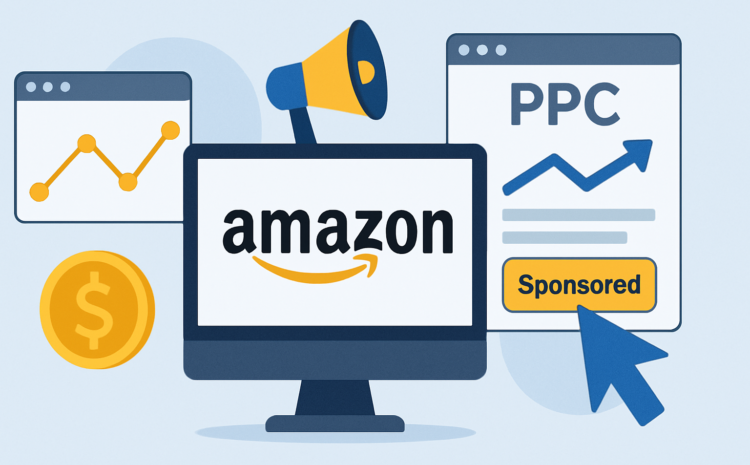Amazon PPC Advertising Strategy
Amazon PPC Advertising Strategy: How to Optimize Campaigns for Higher ROI
Introduction
Amazon has become one of the most competitive marketplaces in the world. With millions of products listed, simply having a great product isn’t enough—you need Amazon PPC advertising to stand out. Running Amazon PPC ads effectively can significantly boost your product visibility, drive traffic, and increase conversions. However, without a well-optimized strategy, you can end up overspending while getting little return.
In this guide, we’ll break down Amazon PPC advertising strategies that help maximize your ROI, lower ACoS, and scale your business efficiently.
Chapter 1: Understanding Amazon PPC Advertising
What is Amazon PPC Advertising?
Amazon Pay-Per-Click (PPC) advertising is an auction-based system where sellers and brands bid on keywords to have their products displayed prominently in search results and product pages. You only pay when someone clicks on your ad, making it a cost-effective way to drive targeted traffic to your listings.
Why Amazon PPC is Important?
✔ Increases visibility – Helps your product appear on top of search results.
✔ Boosts organic ranking – More sales through ads improve your organic ranking.
✔ Drives conversions – Attracts potential buyers actively searching for products.
✔ Provides data insights – Helps you understand what keywords and audiences convert best.
Chapter 2: Types of Amazon PPC Ads
Amazon offers different types of PPC campaigns. Each serves a unique purpose and should be used strategically.
1. Sponsored Products Ads
- Appear in Amazon search results and product detail pages.
- Ideal for individual product promotion.
- Targets keywords, ASINs, and categories.
2. Sponsored Brands Ads
- Display at the top of search results with brand logo and multiple products.
- Great for brand awareness and showcasing product collections.
3. Sponsored Display Ads
- Appear on and off Amazon, targeting specific audiences based on shopping behavior.
- Best for retargeting customers who have viewed your products.
4. Amazon DSP (Demand-Side Platform)
- A programmatic ad service that reaches audiences across Amazon and third-party sites.
- Ideal for advanced targeting and brand growth.
Each of these ad types plays a role in a well-rounded Amazon PPC strategy.
Chapter 3: Setting Up Your Amazon PPC Campaigns
1. Define Your Goals
Before launching Amazon PPC ads, set clear objectives:
✔ Brand Awareness – Increase impressions and engagement.
✔ Sales Growth – Drive conversions and revenue.
✔ Profit Maximization – Optimize ACoS and increase ROI.
2. Keyword Research & Selection
Keywords are the foundation of any successful Amazon PPC advertising strategy. Use tools like:
- Helium 10
- Jungle Scout
- Data Dive
- Amazon Ad Manager
💡 Keyword Types to Target:
✔ Broad Match – Good for reaching a wider audience.
✔ Phrase Match – Targets customers searching for specific phrases.
✔ Exact Match – Highly relevant but narrower audience.
✔ Negative Keywords – Avoid irrelevant clicks and wasted ad spend.
3. Campaign Structure & Budgeting
A well-organized campaign leads to better performance and easier optimization.
🔹 Best practice: Use a 3-tier campaign structure:
✔ Automatic Campaigns – For keyword discovery.
✔ Manual Campaigns – For targeted keyword control.
✔ Competitor Targeting Campaigns – To bid on competitor ASINs.
Set daily budgets that align with your goals and gradually increase investment in high-performing campaigns.
Chapter 4: Amazon PPC Optimization Strategies
1. Lowering ACoS for Higher Profitability
ACoS (Advertising Cost of Sale) = (Ad Spend / Ad Revenue) × 100
To optimize ACoS:
✔ Adjust Bids – Increase bids for high-converting keywords, decrease for low-performing ones.
✔ Use Negative Keywords – Prevent wasted spend on irrelevant searches.
✔ Optimize Listings – High-quality images, bullet points, and descriptions improve conversion rates.
2. Improving Click-Through Rate (CTR)
✔ Use High-Quality Product Images – First impressions matter.
✔ Write Compelling Ad Copy – Highlight unique selling points.
✔ Experiment with Pricing & Offers – Competitive pricing and coupons attract clicks.
3. Scaling Profitable PPC Campaigns
Once you identify profitable campaigns:
✔ Increase budget allocation to top-performing campaigns.
✔ Expand keyword targeting to find additional revenue streams.
✔ Use Sponsored Brands & Display Ads to reach new audiences.
4. Leveraging Amazon PPC Experts & Tools
Hiring an Amazon PPC specialist or an Amazon PPC management service can save time and maximize results. Experts use data-driven strategies and advanced automation tools to optimize campaigns efficiently.
Chapter 5: Common Amazon PPC Mistakes to Avoid
🚨 1. Ignoring Negative Keywords – Leads to wasted ad spend.
🚨 2. Running Only Automatic Campaigns – Limits control over targeting.
🚨 3. Not Monitoring ACoS & ROAS – Overspending on ineffective campaigns.
🚨 4. Poor Product Listings – Even great ads can’t fix a bad product page.











